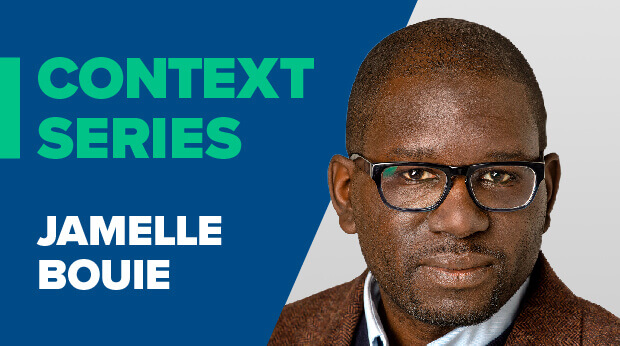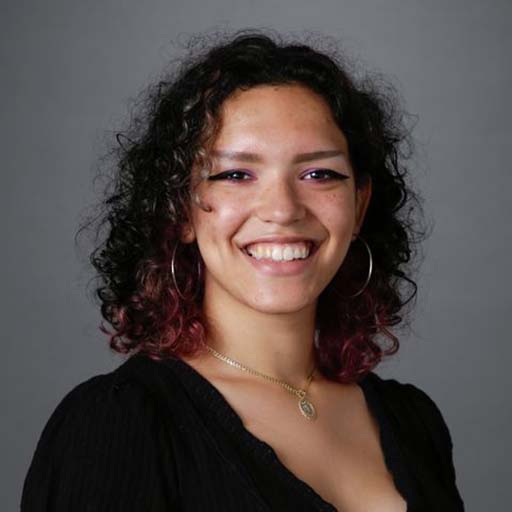News
Poly Context Features New York Times Columnist Jamelle Bouie
What is freedom? Is its meaning different to the person who dominates from what it means to the person who is dominated?

Poly Prep’s Context speaker series seeks to shed light on current issues by looking at them through a historical lens. On February 9, we were pleased to welcome New York Times columnist Jamelle Bouie as our guest to explore the idea of “White Freedom.” Bouie joined Poly’s AP European History and AP U.S. Government and Politics students via Zoom for an exciting discussion based on Tyler Stovall‘s book, White Freedom, which the students had read.
In addition to writing for the Times, Bouie is a political analyst for CBS News. Prior to the Times, Bouie was chief political correspondent for Slate magazine and a staff writer at The Daily Beast. He graduated from the University of Virginia with a degree in political and social thought, and government.
What Does ‘White Freedom’ Mean?
As someone who considers and writes about our current issues in a historical context, Bouie said he was taken with Stovall’s book and what it had to say about race and freedom.
In a December 17, 2021 New York Times opinion piece, “What Does ‘White Freedom’ Really Mean?” Bouie wrote: “But in a recent book, Tyler Stovall…asks us to consider the idea that to its defenders, hierarchy is a matter of freedom and liberty, and to think about what this means for the concepts themselves.”
“…it means that we should think of freedom in at least two ways: a freedom from domination and a freedom to dominate.”
“Specifically,” Bouie continued, “it means that we should think of freedom in at least two ways: a freedom from domination and a freedom to dominate. In White Freedom: The Racial History of an Idea, Stovall shows how both are tied up in the history of race and racial thinking. In societies like those of the United States and republican France, he writes, ‘belief in freedom, specifically one’s entitlement to freedom, was a key component of white supremacy.’ The more white one was, he continues, ‘the more free one was.’”
Students Lead Salon Style Discourse

Chair of the History Department Maggie Moslander thanked Bouie for engaging in this conversation about Stovall’s book with our students and community members. She introduced the first student, Emily Melcer ’22, who read a passage from White Freedom (page 119) about the late 18th century when “Americans could justifiably assume that to be free meant to be white and vice versa. Above all, however, white views of Blacks as inferior meant they could not be free men because in a sense they were not men at all.”
Melcer then posed her question to the group: “Which key moments in the construction of whiteness can help us understand the concept of white freedom?”
Claudia LeDuc ’22 brought up the idea that “property became a symbol of enlightenment… the idea of the enlightened man was one who owned property.”
Bouie followed up on this by pointing out the roots of property relationships in the 17th and 18th centuries and the “emergence of race-based chattel slavery.” He stressed this relationship between labor and property throughout the discussions and pointed out, “If the cotton gin was never invented, slavery would not have been profitable.”

Cameron Lardner ’22 read a passage from page 138 and then posed the question: “Because liberal democracy and the racialization of liberty emerged together out of the Enlightenment, is it possible for either to exist without the other? Why or why not?”
In response, Ryantony Exuma ’22 talked about the “tension between the two ideas” of the individual versus democracy. He spoke about “exploiting the idea of the other” and whether the narrative that has developed over the past 200 years can change.
“I would encourage everyone,” said Bouie, “to think about the development of these ideas and how they get entangled.” He asked them to consider, “What are the material things happening that strengthen or weaken race and freedom?”

Isaac Smith ’22 read passages from pages 127 and 192 that considered race in relation to Haiti and World War I. His question for the group was: “We often think of the Haitian Revolution as the paradigmatic example of the construction of Black freedom. Did WWI also contribute to this construction? How does it compare to the Haitian Revolution in the deconstruction of white freedom?
Lami Diallo ’22 responded, “World War I was between imperial empires,” but that it was “not fair to say World War I deconstructed freedom.”
Bouie pointed out that after World War I, “colonial empires still existed.” He cited the outbreak of racial violence in 1919, known as “Red Summer,” when there was the fear that black soldiers returning from the war would want more freedom.

Anne Vasquez ’22 posed a question in response to text on page 278 about parallels between Civil Rights legislation of the 1960s and the 14th and 15th amendments. “Why did the 14th and 15th Amendments fail to uproot white freedom in America? What are the limits of relying on the legal system to create change?”
Jake Zrihen ’22 said that changes happen not through laws, but “how there is social enforcement.”

Bouie said he did not want to sound like a “broken record,” but stressed again, “Look to the relationship between labor, property, and class.”
Ben Mansfield ’22 read a passage about Japanese internment during World War II on page 239 and asked the question, “In a country in which even the prosecution of a ‘good war’ represents an ‘extreme example of the overarching theme of white freedom,” my question is this: Can America’s definition of freedom be saved from its association with racism? Is it possible to build a truly equitable and equal country from a foundation of inequality and ‘white freedom’?”

Gabrielle Perry ’22 answered, “No. Black Americans are still persecuted,” and said she could not see a remedy to the problem.
Bouie said he liked the example of Japanese internment, as the Japanese in California were successful farmers before internment. Again he cited “how racism and property interests act in concert.” He added, “You can build an equitable country, but less on people changing minds and more on change in economic distribution.”
The discussion concluded with a Q&A from the community attendees about Bouie’s work. He shared with us that as a reader of history, “There is all this fascinating work being done.” He urged the students to “use history to share new perspectives… broaden the set of ideas that are on the table.”



